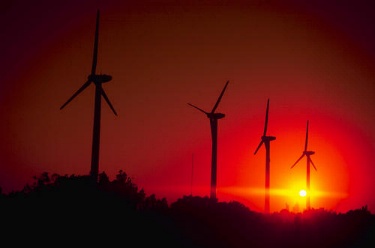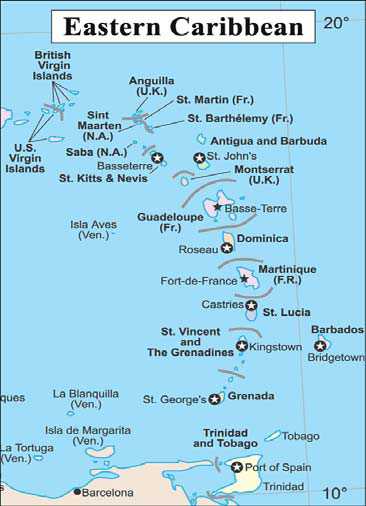Tiempo Climate Cyberlibrary
Global Sustainable Energy Islands Initiative
- Tiempo archive
- Complete issues
- Selected articles
- Cartoons
- Climate treaty
- Latest news
- Secretariat
- National reports
- IPCC
About the Cyberlibrary
The Tiempo Climate Cyberlibrary was developed by Mick Kelly and Sarah Granich on behalf of the Stockholm Environment Institute and the International Institute for Environment and Development, with sponsorship from the Swedish International Development Cooperation Agency.
While every effort is made to ensure that information on this site, and on other sites that are referenced here, is accurate, no liability for loss or damage resulting from use of this information can be accepted.
 |
Tom Roper outlines a global initiative aimed at supporting renewable energy and energy efficient projects as well as national energy plans in small island states. The author is project director of the Global Sustainable Energy Island Initiative and is also a board member of the Washington DC-based Climate Institute. |
The forty-three members of the Alliance of Small Island States (AOSIS) are among the most vulnerable to global climate change with its accompanying sea level rise and increased extreme weather events.
Most Small Island Developing States are already ill-equipped to deal with their existing environmental problems, such as coastal and coral degradation, explosive population growth, over development and pollution. These problems will worsen as the impacts of land submergence, beach erosion, coral damage and storms take their toll.
Climate change threatens the very existence of many AOSIS members even though they are the innocent, the smallest emitters of greenhouse gases. Nations such as the Maldives, Tuvalu and Kiribati are just a few metres above sea level.
Compounding the challenge of global warming, most Small Island Developing States struggle with expensive and sometimes unreliable fossil fuel imports. Diesel is the dominant source of electricity, at least for those with it, and can cost as much as US40 cents/kWh. Seventy per cent of Pacific Islanders, however, still do not have access.
|
The Honourable Neroni Slade, former chair of AOSIS and Samoa's then Ambassador to the United Nations |
Fortunately, though, the need for change has coincided with the greater affordability and availability of alternatives to fossil fuel. The cost of renewable energy has come down dramatically. Small Island Developing States are especially suited to utilize combinations of modern renewable energy technologies and energy efficiency measures.
Finding an international solution
Some years ago, Ambassador Slade challenged the Climate Institute, a Washington DC-based non-governmental organization, to work with AOSIS to find energy solutions.
As a result, the Global Sustainable Energy Islands Initiative (GSEII) has been organized to support Small Island Developing States and potential private investors and donors by bringing renewable energy and energy efficiency projects, models and concepts together into national sustainable energy plans. The GSEII, a consortium of international non-governmental organizations and multilateral institutions, seeks to showcase national efforts that significantly reduce greenhouse gas emissions.
The Global Sustainable Energy Islands Initiative was launched with a grant from the Rockefeller Brothers Fund. This grant enabled the consortium to initiate sustainable energy plans and policies as well as communications and outreach in three Caribbean countries - St Lucia, Grenada and Dominica - as well as other AOSIS nations.
The United States Department of Energy and the Turner Foundation were also initial supporters of GSEII.
The United Nations Foundation has enabled the consortium to advance projects in these three island nations as well as to expand activities to other island nations within the Caribbean and the Pacific. This grant will also help in identifying and developing financing for replication in the region. The United Nations Industrial Development Organization is the executing agency and partner.
|
|
© GSEII |
More recently, the consortium has also received support from two new funders - the United States Agency for International Development and the Renewable Energy and Energy Efficiency Partnership.
The Organization of American States, a consortium member, has also obtained support from the Global Environment Fund and the United Nations Development Programme to develop a pre-feasibility study for geothermal resource assessment in Dominica, St Lucia and St Kitts and Nevis.
|
The GSEII Consortium The Climate Institute is a non-profit organization founded in 1986 to serve as a bridge between policy makers and scientists around the world, as well as between developed and developing nations. The Institute promotes cooperative international action to address climate change. Contact: nkhattak@climate.org Counterpart International, set up in 1965 as the Foundation for the Peoples of the South Pacific, is involved in the successful rural energy programme in Kiribati. It works with island communities in the areas of capacity building, sustainable energy, climate change, biodiversity, marine resource management and environmental protection. Contact: info@counterpart.org The Energy and Security Group assists clients to address critical energy and natural resources issues at the nexus of national and international security interests. The Group promotes the use of environmentally-responsible energy solutions through the following business services: energy security analysis; project support; financial engineering; policy support; and technical assistance and training. Contact: judy@energyandsecurity.com The International Network for Sustainable Energy (INFORSE) is a European-based global network of independent non-governmental organizations working for sustainable energy solutions to reduce poverty and protect the environment. INFORSE is a worldwide network consisting of over 140 non-governmental organizations working in over 60 countries. Contact: ove@inforse.org The Organization of American States is a multi-lateral organization for the nations of the Americas and currently serves as the coordinating institution for the Renewable Energy in the Americas initiative, which offers technical, policy and financial assistance for the promotion of sound energy solutions throughout the region. Contact: lambrides@oas.org Winrock International is a non-governmental organization working with people around the world to increase economic opportunity, sustain natural resources and protect the environment. Winrock's Clean Energy Group is a recognized leader in the field of clean energy and operates a multimillion dollar programme, including Renewable Energy Project Support Offices in ten countries. Contact: jpg@winrock.org |
The GSEII strategy
To accelerate the transition of AOSIS member nations toward cleaner, more sustainable energy use, the GSEII employs the following approach to both broaden and deepen sustainable energy development activities:
- work with partner countries on the development and implementation of Sustainable Energy Plans, with quantifiable targets and timetables;
- identify and mitigate policy, financing, technical and institutional obstacles and bring about changes in the marketplace that will enhance the viability, profile and replicability of clean energy projects;
- work with utilities to enhance their capacity for renewable energy planning and help transform these utilities from diesel-based generation to renewable energy systems;
- catalyse private investment in renewable energy (such as biomass, geothermal, hydropower, photovoltaics, solar thermal and wind technologies) and energy efficiency opportunities;
- build and strengthen local capacity at national and regional levels to continue to develop and implement sustainable energy options and approaches; and,
- demonstrate that energy can be used as a tool for sustainable development and poverty reduction, thereby contributing to attainment of the Millennium Development Goals.
The challenge
Though Small Island Developing States are especially suited to utilize combinations of modern renewable technologies and energy efficiency due to the availability of renewable energy resources and current energy consumption patterns, there are difficulties in achieving this potential.
Most Small Island Developing States lack technical knowledge and skilled personal, and there are still too few successful demonstration projects that can be seen and touched.
Utilities depend on diesel, and their staffs have little or no experience of renewables or access to resource assessments. The Maldives, for instance, at the time of initiating plans, had no engineer with renewable energy expertise.
In addition, renewables often have a high upfront cost, while utilities suffer from a scarcity of finance.
The Cabinet of the beautiful Caribbean nation of St Lucia was the first to approach GSEII for assistance. Working with the government, utility, business and the community, a comprehensive energy plan has been prepared and adopted by the Cabinet. The aim is to have renewables account for new capacity, replace outdated diesels and encourage energy efficiency.
Dominica and Grenada have joined the project and jointly announced their ambitious targets at the World Summit in Johannesburg.
|
|
© GSEII |
Dominica's former Prime Minister, the late Pierre Charles, said "my country, known as the Nature Island of the Caribbean, has long embraced the principles of sustainable development and sees clean energy as a fundamental requirement for economic and social progress." The national target, building on existing 33 per cent use of hydropower, aims to achieve 65 per cent renewable energy use by 2010.
"Our dependence on expensive foreign energy has done nothing to help development or deliver affordable energy to the poor. Small Island States need support from developed nations to succeed in their energy plans - technical assistance, new technologies, soft financing and joint venture partners," he added.
|
Requirements for developing national sustainable energy plans
Success will require capacity building, community education and awareness campaigns, and the sharing of experiences with other regions and islands. It will also need hitherto scarce donor, international bank and private sector investment. If success is not achieved, there is a real risk that most Small Island Developing States will miss out on opportunities for the sale of carbon offset credits through the Clean Development Mechanism. |
The GSEII five-year sustainable energy plan
As a result of assessing the immediate energy needs of the small islands, the GSEII developed an ambitious five-year plan.
The fundamental aims of the plan are to assist several Small Island Developing States that are members of AOSIS in achieving energy independence and thus to serve as successful models for the rest of the world.
The GSEII's strategies and plans run from 2003 to 2008. It is expected that the following outcomes will be achieved as a result of implementing this five-year plan:
- approved National Sustainable Energy Action Plans by over twelve Small Island Developing States;
- enhanced capacity for national energy planning and renewable energy/energy efficiency policy implementation;
- commitment and/or leverage of US$100 million in investment in renewable energy/energy efficiency projects and enterprises;
- initiation of energy efficient projects in government facilities, commercial, residential and industrial sectors, especially in the hotels and tourism industry;
- initiation of fifteen new projects in the AOSIS member nations and plans for at least 100MW of clean energy projects (new and renewable energy projects or equivalent savings through efficiency measures) facilitated with corresponding greenhouse gas emissions reductions;
- enhanced capacity for renewable energy and efficiency at a regional level and among all 43 members of AOSIS; and,
- catalysing the interest of other bigger nations to follow the Small Island Developing States example.
Initial successes
The Fiji Department of Energy has, amongst other initiatives, developed a village-based hybrid wind, solar and diesel scheme, and provides mini hydro and coconut oil options elsewhere. The Fiji Electricity Authority is negotiating for a major wind power investment to service the grid.
Encouraged and assisted by the Pacific Power Association, the ocean-wide regional electric utilities organization, five Pacific nations and the European Union are finalizing individual country sustainable energy projects.
Elsewhere, the Unit for Sustainable Development and Environment of the Organization of American States is executing a Global Environment Facility project to support geothermal energy development in the Eastern Caribbean.
|
|
© GSEII |
The Eastern Caribbean Geothermal Development Project (Geo-Caraïbes) seeks to catalyse commercial geothermal energy projects in St Lucia, Dominica and St Kitts and Nevis with the expectation that regional power independence will contribute significantly to the economic and environmental sustainability in the region.
Geo-Caraïbes intends to achieve this goal by supporting market reforms that improve the market conditions for geothermal power in these countries. The following are the main avenues of support:
- establishing a transparent pro-active and commercially-sound geothermal policy and legal environment;
- furthering geothermal resource/technical studies for commercial investment pre-selection;
- conducting the technical evaluation and establishing the institutional arrangements for the export of geothermal power to Martinique and/or Guadeloupe;
- creating a US$10 million Eastern Caribbean Geothermal Energy Drilling Risk Fund; and,
- organizing a process to attract/negotiate with world class geothermal project developers to invest in projects.
It is expected that a large quantity of geothermal energy capacity (60-120MW) will be developed and that the resulting power will offer the host countries a low-cost power solution. At the same time, this will enable them to generate substantial income as an export to Martinique and/or Guadeloupe via submarine electricity transmission cables.
In St Lucia, Grenada and Dominica, the GSEII has assisted in developing National Sustainable Energy Plans as well as preparing projects for investments. As a result of these plans, and working closely with local utilities and private sector entrepreneurs, a number of projects have been identified. GSEII and its partners are providing technical assistance in further development and implementation of these projects.
|
Ongoing projects
and projects to be implemented |
|
|
St Lucia |
|
|
Grenada |
|
|
Dominica |
|
GSEII will also work with the local governments and project developers on the development and packaging of projects for carbon financing through the Clean Development Mechanism, the Prototype Carbon Fund and other sources.
These efforts will be coordinated by the GSEII by working closely with existing regional organizations and multilateral initiatives. These include the Caribbean Renewable Energy Development Programme, the Organization of Eastern Caribbean States, the Caribbean Energy Information Systems, the United Nations Development Programme and the Global Environment Facility.
|
Ambassador Enele Sopoaga of
Tuvalu, Vice Chairman of AOSIS, |
In conclusion
The GSEII partners aim to continue their Caribbean work, possibly adding additional nations, and to help develop sustainable energy plans for Pacific and Indian Ocean countries. The United Nations-sponsored review meeting of the 1994 Barbados Plan of Action to be held in January in Mauritius provides an excellent opportunity for the showcasing of successful demonstration projects.
We must show the Mauritius participants and the international community that sustainable energy is not only an environmental necessity, but also makes economic and social sense.
Further information
Tom Roper, Climate Institute, 1785 Massachusetts Avenue NW,
Washington DC 20036, USA. Fax: +1-202-5470111. Email:
troper@nyc.rr.com.
Web: www.climate.org.
On the Web
Further information concerning the review of progress in
implementing the Barbados
Programme of Action for the Sustainable Development of
Small Island Developing States can be found at the conference
website. The Tiempo Climate Cyberlibrary presents a
listing of theme
sites and articles on Small Island Developing
States.
Acknowledgements
Parts of this feature have been extracted from an article
by the author in
New Academy Review.
Bright Ideas

General Electric plans to cut solar installation costs by half

Project 90 by 2030 supports South African school children and managers reduce their carbon footprint through its Club programme

Bath & North East Somerset Council in the United Kingdom has installed smart LED carriageway lighting that automatically adjusts to light and traffic levels

The United States National Oceanic and Atmospheric Administration and the American Public Gardens Association are mounting an educational exhibit at Longwood Gardens showing the link between temperature and planting zones

The energy-efficient Crowne Plaza Copenhagen Towers hotel is powered by renewable and sustainable sources, including integrated solar photovoltaics and guest-powered bicycles
El Hierro, one of the Canary Islands, plans to generate 80 per cent of its energy from renewable sources

The green roof on the Remarkables Primary School in New Zealand reduces stormwater runoff, provides insulation and doubles as an outdoor classroom

The Weather Info for All project aims to roll out up to five thousand automatic weather observation stations throughout Africa

SolSource turns its own waste heat into electricity or stores it in thermal fabrics, harnessing the sun's energy for cooking and electricity for low-income families

The Wave House uses vegetation for its architectural and environmental qualities, and especially in terms of thermal insulation

The Mbale compost-processing plant in Uganda produces cheaper fertilizer and reduces greenhouse gas emissions

At Casa Grande, Frito-Lay has reduced energy consumption by nearly a fifth since 2006 by, amongst other things, installing a heat recovery system to preheat cooking oil
Updated: May 15th 2015
 The Small Island States can, by
promoting a clean energy environment, set an example
for the rest of the world. Too much of our national
budgets are spent on fossil fuels for diesel
generation of electricity. This is a drain on our
economies and does not work towards a solution to the
problems of climate change. When the tanker comes in,
the foreign reserves go out. Far too little attention
has been given amongst the Small Island States
leadership and by the donor countries to the
development of alternative means of energy.
The Small Island States can, by
promoting a clean energy environment, set an example
for the rest of the world. Too much of our national
budgets are spent on fossil fuels for diesel
generation of electricity. This is a drain on our
economies and does not work towards a solution to the
problems of climate change. When the tanker comes in,
the foreign reserves go out. Far too little attention
has been given amongst the Small Island States
leadership and by the donor countries to the
development of alternative means of energy.


 Clearly, the element of urgency to
switch to efficient, affordable and renewable energy
sources is real. Whilst in global terms the energy
use in small island states is small, and their
polluting-emissions minimal, the AOSIS countries have
shown many a time that they stand ready to do their
part to contribute to the reduction of global
emissions through the promotion of renewable energy.
Every contribution counts, however small. Our
interest in moving the global economy towards less
carbon intensive is not self-serving, for the
consequences that we are first to encounter will
surely be felt by others.
Clearly, the element of urgency to
switch to efficient, affordable and renewable energy
sources is real. Whilst in global terms the energy
use in small island states is small, and their
polluting-emissions minimal, the AOSIS countries have
shown many a time that they stand ready to do their
part to contribute to the reduction of global
emissions through the promotion of renewable energy.
Every contribution counts, however small. Our
interest in moving the global economy towards less
carbon intensive is not self-serving, for the
consequences that we are first to encounter will
surely be felt by others.